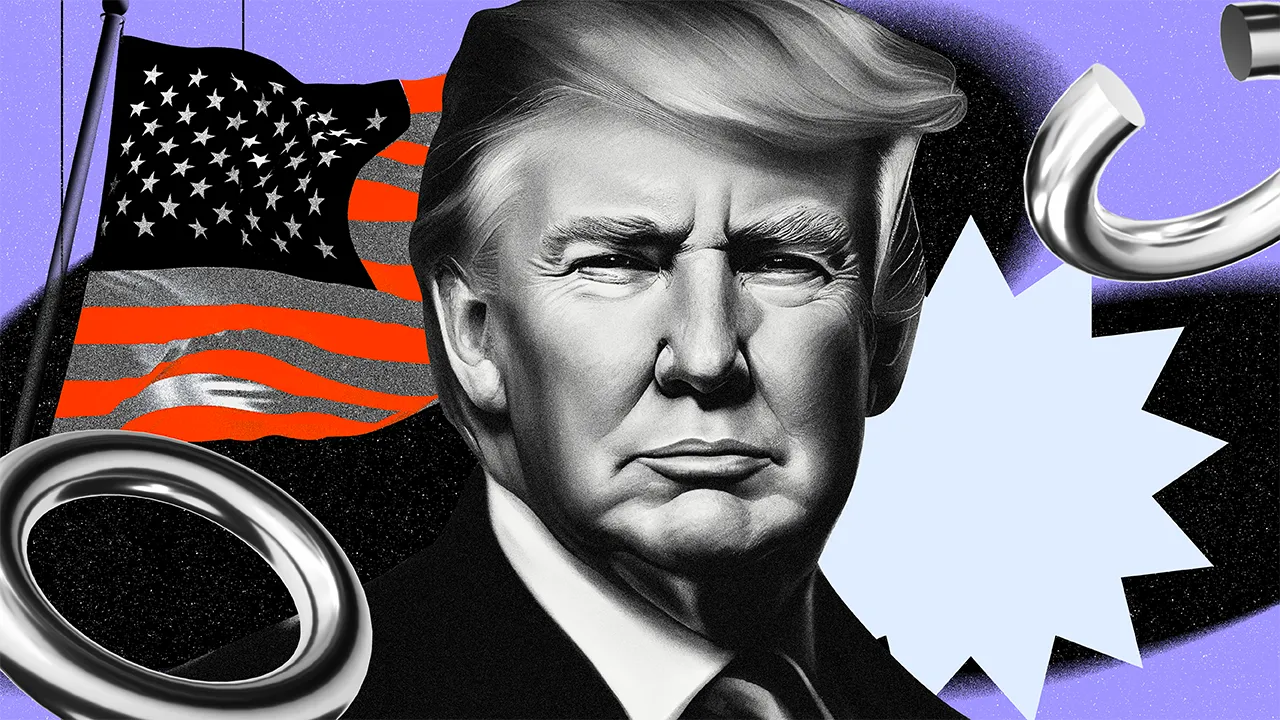Bitcoin
The Future of Decentralized Lending?

According to the World Bank, 1.4 billion adults around the world remain unbanked. The global financial system, despite its unbelievably vast infrastructure, falls short of serving the global population equitably on many counts.
For many, the glittering promise of financial freedom is not merely a matter of surviving the rat race but also a tale of inflation and documentation.
Bitcoin-Backed Credit: A Lifeline for the Unbanked Globally
Millions of people remain underbanked or entirely unbanked due to strict credit requirements, high fees, and limited accessibility. From Palestinian refugees with no proof of citizenship, single women with no employment contract in Egypt, or the countless people facing exorbitant inflation rates of over 120% in Argentina.
During the 2008 financial crisis, countless individuals in the US lost their homes due to predatory lending practices, showcasing the system’s inherent vulnerabilities. Even today, high inflation erodes savings in fiat currencies, leaving consumers with fewer options to preserve their wealth.
Meanwhile, small businesses worldwide face rejection from banks due to rigid creditworthiness standards. One may even argue that money is perhaps the most violent political tool in the weaponry bag of the powers that be.
This gap in accessibility and fairness reveals the need for alternative financial systems. Bitcoin-backed credit offers a viable solution, overcoming both the political agendas and the economic limitations that keep poor people poor.
What Are Bitcoin-Backed Credit Systems?
Bitcoin-backed credit systems allow borrowers to use their BTC holdings as collateral to secure loans without selling their assets. These systems function similarly to secured loans, where a borrower pledges an asset to access liquidity.
If the borrower fails to repay, the lender liquidates the collateral to recover the funds. Unlike traditional loans, these systems do not require credit scores or extensive documentation, making them more accessible to crypto holders.
“High inflation, currency devaluation, and low trust in centralized banks could drive demand for Bitcoin-backed loans. Bitcoin’s stability and decentralized nature make it attractive in volatile economies, and DeFi platforms offer lower barriers and better terms compared to traditional lending,” Kevin Charles, co-founder of The Open Bitcoin Credit Protocol told BeInCrypto in an interview.
The market for Bitcoin-backed credit has grown, with key players like BlockFi, Ledn, Celsius, and Nexo leading the way. These platforms allow users to retain exposure to BTC while accessing fiat or stablecoin liquidity. The simplicity and appeal of these systems have fueled their adoption in recent years, one reason why they have faired peacefully throughout bear markets.
One major advantage of BTC-backed credit is the ability to retain exposure to Bitcoin’s price appreciation. Borrowers can unlock liquidity without selling their BTC, allowing them to benefit from potential long-term gains.
Additionally, Bitcoin-backed loans act as a hedge against inflation by offering an alternative to the ever-devaluing fiat currencies. A crypto holder in Argentina, for example, would be able to secure themselves against their dwindling national currency and even make extra cash.
According to Bankrate, USD now has an inflation rate of 2.4%, which is notably the lowest it has been since February 2021. Meanwhile, BTC has an inflation rate of just 1.7%.

BTC-backed systems also promote financial accessibility. Unlike traditional banks, which require stringent credit checks, Bitcoin-backed credit platforms primarily assess the value of the collateral. This approach opens the door to individuals in regions with limited banking infrastructure, offering a lifeline to the unbanked.
For those who hold true to the ethos of decentralization, global inclusion is the real selling point. Bitcoin-backed credit has the potential to provide financial services to these populations, bridging the gap left by traditional systems. Central banks and global financial institutions remain privy to the whims and shifts of the ever-changing political playground.
In a nation like Lebanon, whose residents primarily transact in USD due to its effectively dead LBP, citizens were barred from withdrawing their own dollars when the central bank faced a dollar shortage crisis. For reference, one USD equals 89,550 LBP. In neighboring Egypt, rumors of impounded USD accounts also began circulating before being denied by central bank officials.
“Bitcoin-backed credit operates on a global, decentralized network, meaning access is not dependent on income, location, or credit history. By using Bitcoin as collateral, anyone holding the asset can access loans without traditional gatekeepers. Early DeFi platforms show increasing adoption in regions with limited banking access, highlighting the potential for financial inclusion,” Charles added.
However, even with all of these advantages, duality is the law of the universe. Bitcoin-backed credit systems are no cure-all solution; they carry significant risks.
The most glaring is Bitcoin’s price volatility. A sudden drop in BTC’s value can trigger margin calls, forcing borrowers to either add collateral or face liquidation. During the crypto market crash in 2022, countless borrowers lost their collateral as prices plummeted. According to Charles, there are ways to mitigate volatility.
“Volatility is managed through over-collateralization and automated liquidations. By requiring more collateral than the loan value, platforms create a buffer against price drops. Additionally, real-time monitoring ensures loans are adjusted to market conditions, maintaining stability even during price crashes,” Charles added.
The Three-Eyed Trojan Horse: Centralization’s Re-emergence
Even so, Bitcoin-backed credit systems have socio-economic implications that warrant examination. The first is that while these platforms democratize access to credit for crypto holders, they risk creating new financial gatekeepers. Wealthy crypto investors, or “crypto whales,” stand to benefit the most, while average users with limited holdings may find themselves excluded.
Whales, or addresses holding more than 100,000 BTC, hold 21% of the total Bitcoin supply. This dynamic means perpetuating wealth concentration within the crypto space as well. If that does happen, we can wave goodbye to the promise of inclusion.

The second concern is traditional financial institutions. They are increasingly infiltrating the Bitcoin-backed credit market through acquisitions and regulatory influence.
Banks like Goldman Sachs and JPMorgan have begun exploring crypto-backed lending, signaling a convergence of decentralized and traditional finance. In November, Bloomberg reported that Goldman Sachs is preparing to launch a new company focused on digital assets. While these developments bring legitimacy, they also raise concerns about co-opting Bitcoin’s decentralized ethos.
Then enters the third and final Trojan horse: government oversight. It presents both opportunities and challenges for Bitcoin-backed credit systems.
Regulation can legitimize these platforms, ensuring consumer protection and stability. However, excessive regulation could stifle innovation and compromise decentralization.
For example, the European Union’s MiCA framework has introduced clarity but also imposed stringent compliance requirements, causing friction within the crypto industry. Binance, the world’s largest crypto exchange by trading volume, had to disable copy trading services for its European users in June after MiCA was announced.
Another issue that may impact accessibility is know-your-customer (KYC) standards, which may hinder those who rely on crypto wallets because they lack sufficient personal documentation. Policymakers often argue that platforms without strict KYC oversight risk assisting criminals in money laundering operations. In 2023, Turkiye even rolled out a new set of crypto laws aimed at tightening up KYC standards.
“We’re witnessing a re-centralization of a system designed to be free. The challenge is finding balance without diluting Bitcoin’s core principles,” Charles posed.
Platforms like Aave and Sovryn exemplify decentralized approaches to Bitcoin-backed credit. These systems rely on smart contracts to automate transactions, reducing the need for intermediaries and ensuring transparency. However, decentralization comes with its own challenges, including scalability, security vulnerabilities, and regulatory gray areas.
Still, success stories exist. Borrowers have used Bitcoin-backed loans to fund businesses, pay medical bills, or navigate economic uncertainty without selling their BTC. Conversely, others have faced significant losses due to liquidation during market downturns, highlighting the high stakes of these systems.
In conclusion, Bitcoin-backed credit represents both a financial revolution and a cautionary tale. Its future hinges on its ability to scale, remain accessible and adhere to Bitcoin’s ethos of decentralization.
As traditional finance enters the space and regulatory frameworks evolve, the challenge will be maintaining the balance between innovation and inclusivity. Whether these systems democratize finance or merely shift the gatekeeping remains to be seen.
Disclaimer
Following the Trust Project guidelines, this feature article presents opinions and perspectives from industry experts or individuals. BeInCrypto is dedicated to transparent reporting, but the views expressed in this article do not necessarily reflect those of BeInCrypto or its staff. Readers should verify information independently and consult with a professional before making decisions based on this content. Please note that our Terms and Conditions, Privacy Policy, and Disclaimers have been updated.
Bitcoin
BTC Price Rebound Likely as Long-Term Holders Reenter Market

Bitcoin (BTC) is on track to end Q1 with its worst performance since 2019. Without an unexpected recovery, BTC could close the quarter with a 25% decline from its all-time high (ATH).
Some analysts have noted that experienced Bitcoin holders are shifting into an accumulation phase, signaling potential price growth in the medium term.
Signs That Veteran Investors Are Accumulating Again
According to AxelAdlerJr, March 2025 marks a transition period where veteran investors move from selling to holding and accumulating. This shift is reflected in the Value Days Destroyed (VDD) metric, which remains low.
VDD is an on-chain indicator that tracks investor behavior by measuring the number of days Bitcoin remains unmoved before being transacted.
A high VDD suggests that older Bitcoin is being moved, which may indicate selling pressure from whales or long-term holders. A low VDD suggests that most transactions involve short-term holders, who have a smaller impact on the market.
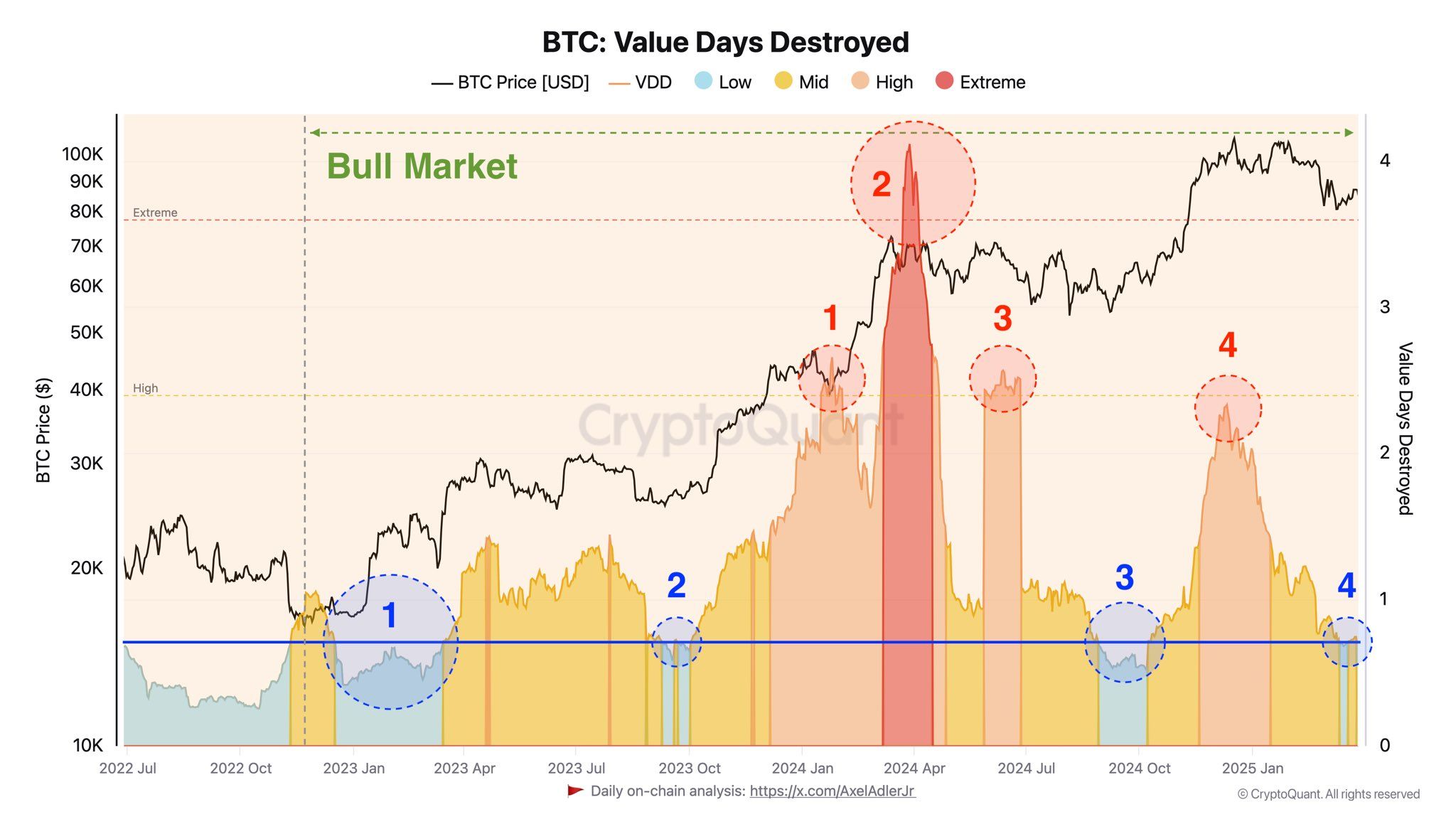
Historically, low VDD periods often precede strong price rallies. These phases suggest that investors are accumulating Bitcoin with expectations of future price increases. AxelAdlerJr concludes that this shift signals Bitcoin’s potential for medium-term growth.
“The transition of experienced players into a holding (accumulation) phase signals the potential for further BTC growth in the medium term,” AxelAdlerJr predicted.
Bitcoin’s Sell-Side Risk Ratio Hits Low
At the same time, analyst Ali highlighted another bullish indicator: Bitcoin’s sell-side risk ratio had dropped to 0.086%.
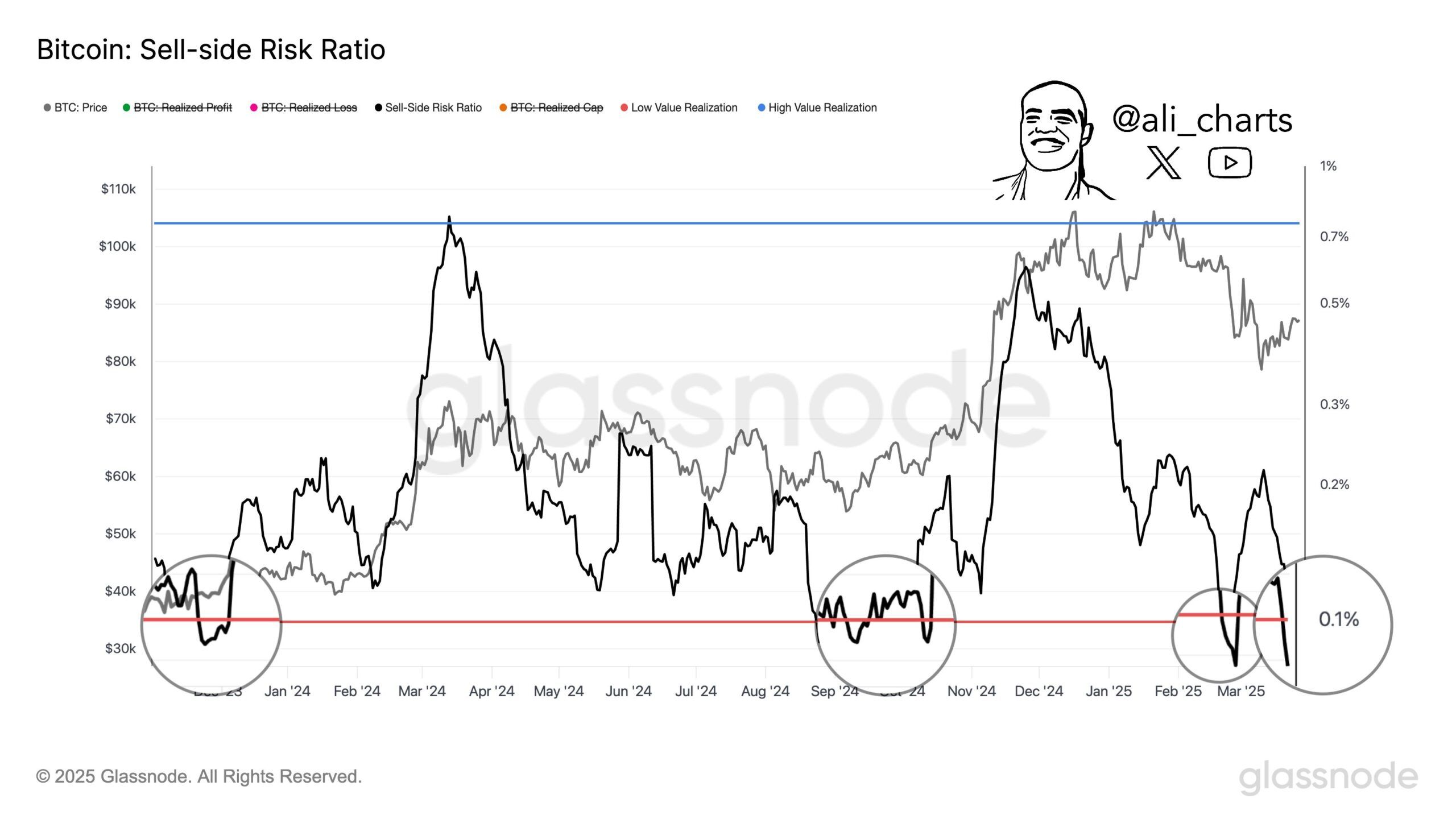
According to Ali, over the past two years, every time this ratio fell below 0.1%, Bitcoin experienced a strong price rebound. For example, in January 2024, Bitcoin surged to a then-all-time high of $73,800 after the sell-side risk ratio dipped below 0.1%.
Similarly, in September 2024, Bitcoin hit a new peak after this metric reached a low level.
The combination of veteran investors accumulating Bitcoin and a sharp decline in the sell-side risk ratio are positive signals for the market. However, a recent analysis from BeInCrypto warns of concerning technical patterns, with a death cross beginning to form.
Additionally, investors remain cautious about potential market volatility in early April. The uncertainty stems from President Trump’s upcoming announcement regarding a major retaliatory tariff.
Disclaimer
In adherence to the Trust Project guidelines, BeInCrypto is committed to unbiased, transparent reporting. This news article aims to provide accurate, timely information. However, readers are advised to verify facts independently and consult with a professional before making any decisions based on this content. Please note that our Terms and Conditions, Privacy Policy, and Disclaimers have been updated.
Bitcoin
Marathon Digital to Sell $2 Billion in Stock to Buy Bitcoin
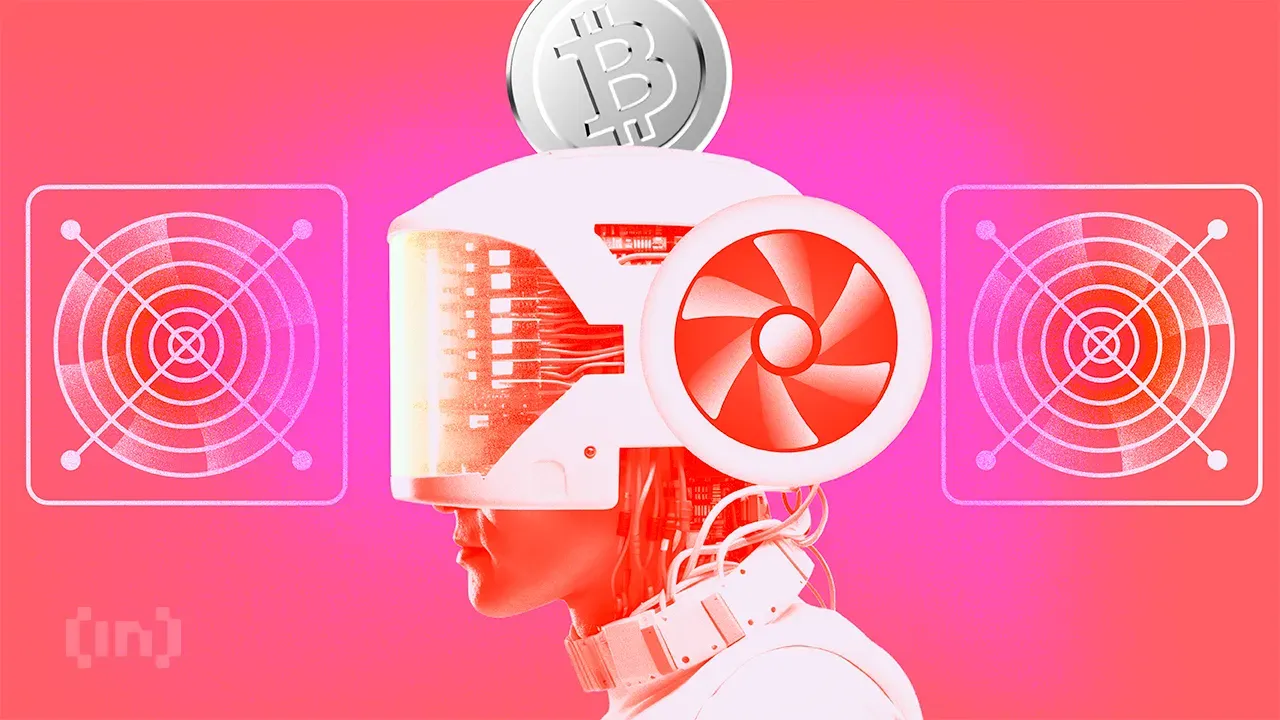
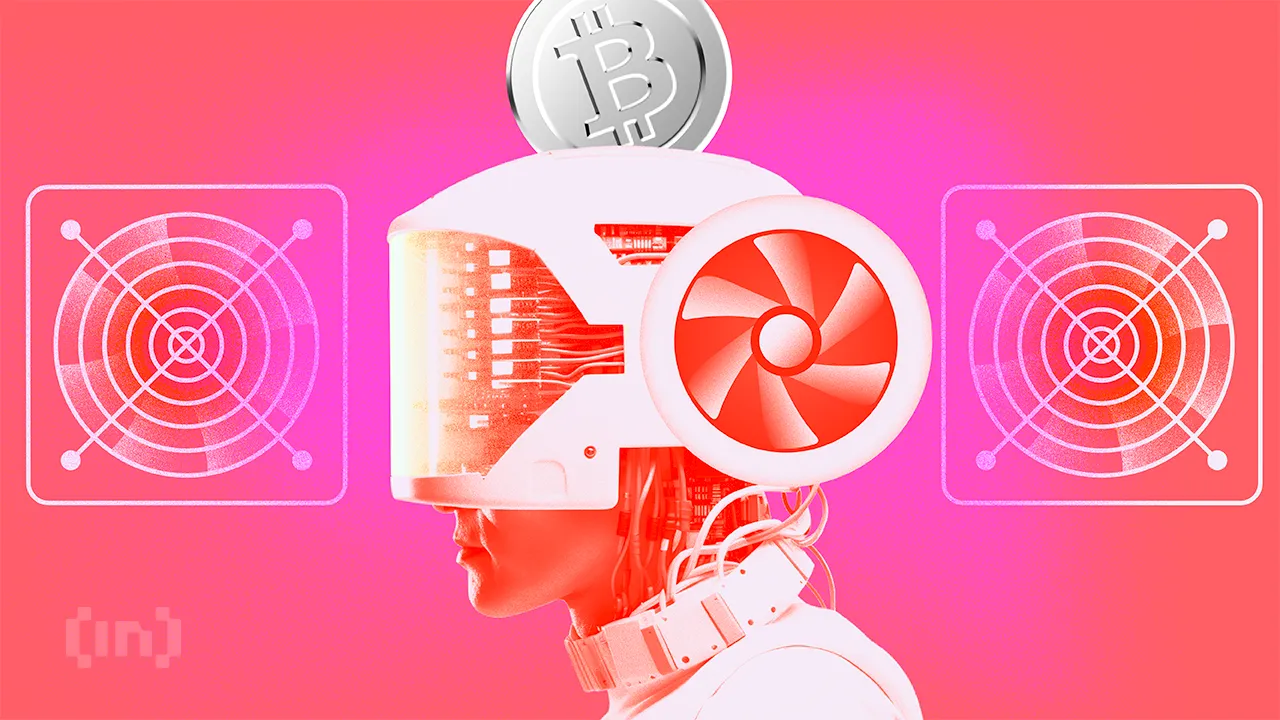
Marathon Digital Holdings, one of the largest Bitcoin mining companies in the US, made headlines with its announcement of a $2 billion stock offering to increase its Bitcoin holdings.
This strategic move, detailed in recent SEC filings, shows Marathon’s aggressive approach to capitalize on the growing crypto market.
Marathon’s $2 Billion Stock Offering: Key Details
On March 30, 2025, Marathon Digital Holdings announced a $2 billion at-the-market (ATM) stock offering to fund its strategy of acquiring more Bitcoin. The company filed a Form 8-K with the SEC, outlining its plan to raise capital through the sale of shares, with the proceeds primarily aimed at increasing its Bitcoin holdings.
According to the SEC filing (Form 424B5), Marathon intends to use the funds for “general corporate purposes,” which include purchasing additional Bitcoin and supporting operational needs.
Marathon holds 46,376 BTC, making it the second-largest publicly traded company in Bitcoin ownership, behind MicroStrategy. The company’s Bitcoin holdings have grown significantly in recent years, from 13,726 BTC in early 2024 to the current figure.
“We believe we are the second largest holder of bitcoin among publicly traded companies. From time to time, we enter into forward or option contracts and/or lend bitcoin to increase yield on our Bitcoin holdings.” Marathon confirmed
This $2 billion stock offering continues Marathon’s strategy to bolster its balance sheet with Bitcoin, a move that aligns with its long-term vision of leveraging cryptocurrency as a store of value.
Marathon’s strategy mirrors that of MicroStrategy. MicroStrategy’s stock price has soared with Bitcoin’s value, providing a blueprint for companies like Marathon to follow. By increasing its Bitcoin holdings, Marathon aims to position itself as a leader in the crypto mining sector while diversifying its revenue streams beyond traditional mining operations.
Marathon Digital CEO Fred Thiel advises investing small amounts in Bitcoin monthly, citing its consistent long-term growth potential.
The issuance of new shares to raise $2 billion could dilute the ownership of existing shareholders, potentially impacting the company’s stock price (MARA). As of March 31, 2025, MARA stock has experienced volatility, trading at around $12.47 per share, down from a 52-week high of $24, according to data from Yahoo Finance.
Moreover, Marathon’s heavy reliance on Bitcoin exposes it to the cryptocurrency’s price fluctuations. If Bitcoin’s price were to decline significantly, the value of Marathon’s holdings would decrease, potentially straining its financial position.
Disclaimer
In adherence to the Trust Project guidelines, BeInCrypto is committed to unbiased, transparent reporting. This news article aims to provide accurate, timely information. However, readers are advised to verify facts independently and consult with a professional before making any decisions based on this content. Please note that our Terms and Conditions, Privacy Policy, and Disclaimers have been updated.
Bitcoin
US Macroeconomic Indicators This Week: NFP, JOLTS, & More

Crypto markets have much to look forward to this week, which marks the end of the first quarter (Q1). As Q2 commences on Tuesday, several US economic data will drive Bitcoin (BTC) and crypto sentiment this week.
Traders and investors will watch a slate of US economic data releases that could ripple through Bitcoin and altcoin prices.
5 US Economic Data To Watch This Week
These US macroeconomic indicators could drive volatility amid fresh insights into the health of the world’s largest economy.
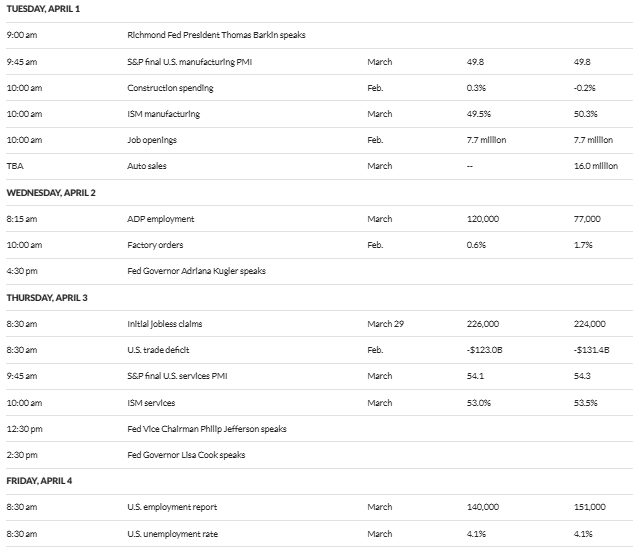
“Buckle up—volatility’s knocking. Right on time for the monthly shake-up,” a user on X quipped.
JOLTS
The first is the Job Openings and Labor Turnover Survey, or JOLTS, due for release on Tuesday, April 1. This report tracks available job vacancies in the US, effectively offering a window into employer confidence and labor market demand.
A strong showing, with openings exceeding recent trends of around 7.7 million, would suggest a strong economy. While this would strengthen the US dollar, it would dampen Bitcoin’s appeal as a hedge against weakness.
Conversely, a sharp drop in openings might stoke expectations of Federal Reserve rate cuts to bolster the economy. This outcome would lift risk assets like Bitcoin and crypto as investors seek alternatives to low-yield bonds.
ADP Employment
Adding to the list of US macroeconomic indicators this week is the ADP Employment report on Wednesday, April 2. This report will provide a private-sector payroll snapshot, serving as a preview of Friday’s main event.
There is a median forecast of 120,000 for March, following the previous month’s 77,000 reading. If job growth tops the consensus forecast, it could reinforce confidence in traditional markets, possibly pressuring crypto prices as the dollar gains ground.
On the other hand, a weaker-than-expected figure, say below 77,000, might hint at a slowdown. This would boost Bitcoin’s allure as a safe haven amid uncertainty. While not as authoritative as the official numbers, surprises here often set the tone for crypto traders adjusting their positions.
Liberation Day
Meanwhile, the stakes are high this week, with the US economy enduring uncertainties like Trump-era policies, including tariffs and government streamlining efforts. BeInCrypto reported on the upcoming Liberation Day, which is expected to bring new tariff announcements targeting nations imposing trade barriers.
“The last two months have already hurt American businesses and consumers, but the April 2 deadline seriously could make all of that look like a tempest in a teapot. We don’t know exactly what they’re going to do, but from what they’re saying, it sounds functionally like new tariffs on all US imports,” said Joseph Politano, economic policy analyst at Apricitas Economics.
Analysts predict extreme market volatility, with potential stock and crypto crashes reaching 10-15% if Trump enforces broad tariffs.
“April 2nd is similar to election night. It is the biggest event of the year by an order of magnitude. 10x more important than any FOMC, which is a lot. And anything can happen, “Alex Krüger predicted.
Initial Jobless Claims
On Thursday, April 3, crypto markets will watch the Initial Jobless Claims report, which shows the number of US citizens filing for unemployment insurance. Released weekly, this is a near-real-time pulse on layoffs and labor market stability.
Fewer claims, under the previous week’s 224,000 reading, could suggest resilience, supporting the dollar but tempering crypto enthusiasm. However, potentially exceeding the median forecast of 226,000 might raise red flags about economic health.
Such an outcome would drive demand for decentralized assets to hedge against potential turmoil. Given its weekly cadence, this report tends to spark quick reactions in the crypto market, especially when amplified by broader narratives like government efficiency cuts or tariff impacts in 2025.
US Employment Report
The week’s crescendo arrives Friday, April 4, with the US Employment Report, widely known as Non-Farm Payrolls. This comprehensive labor market update—including jobs added, the unemployment rate, and wage growth—is a linchpin for markets worldwide.
A strong report, higher than the previous reading of 151,000 jobs and a steady 4.1% unemployment rate, could bolster faith in the economy. This could curb crypto gains if the dollar rallies.
However, strong wage growth exceeding 0.3% month-over-month (MoM) might rekindle inflation fears, indirectly supporting Bitcoin as a store of value.
Conversely, a disappointing tally—under the median forecast of 140,000 jobs with unemployment ticking beyond 4.1%—could ignite recession worries. This would send investors flocking to Bitcoin and crypto.
Significant deviations from consensus forecasts, often by 50,000 jobs or more, have historically triggered sharp Bitcoin moves of 1-2% or greater.
“BofA [Bank of America] Securities expects a pickup in job growth for March. Keep an eye on those numbers,” crypto researcher Orlando noted.
For crypto market participants, the game plan is clear: track consensus estimates on economic calendars, watch real-time reactions, and brace for swings. Nevertheless, this week’s data could dictate Bitcoin’s next move in Q2 2025, particularly in April.
Fed Chair Jerome Powell will also address the economic outlook at the SABEW Annual Conference on Friday at 11:25 a.m. EST.
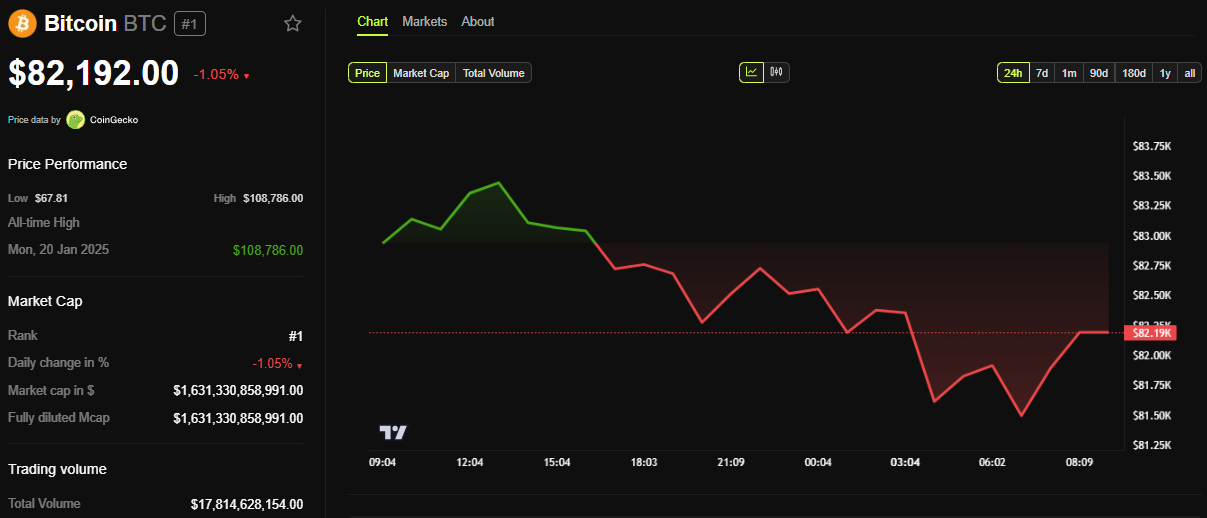
BeInCrypto data shows BTC was trading for $82,192 as of this writing, down by over 1% in the last 24 hours.
Disclaimer
In adherence to the Trust Project guidelines, BeInCrypto is committed to unbiased, transparent reporting. This news article aims to provide accurate, timely information. However, readers are advised to verify facts independently and consult with a professional before making any decisions based on this content. Please note that our Terms and Conditions, Privacy Policy, and Disclaimers have been updated.
-

 Ethereum24 hours ago
Ethereum24 hours agoWhales Accumulate 470,000 Ethereum In One Week – Bullish Momentum Ahead?
-

 Regulation21 hours ago
Regulation21 hours agoJapan Set To Classify Cryptocurrencies As Financial Products, Here’s All
-

 Market23 hours ago
Market23 hours ago3 Token Unlocks for April: Parcl, deBridge, Scroll
-

 Market20 hours ago
Market20 hours agoTop 3 Made in USA Coins to Watch This Week
-

 Market19 hours ago
Market19 hours agoSolana (SOL) Price Risks Dip Below $110 as Bears Gain Control


